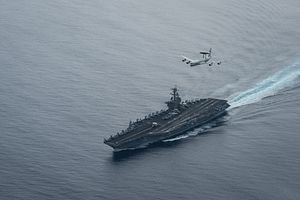In a recent Proceedings article, Admiral Scott Swift, the commander of the U.S. Pacific Fleet, revealed that for the past two years deploying strike groups have conducted “Fleet Problems” following their normal predeployment training. The practice resurrects a series of large exercises conducted by the U.S. Navy in the years between the World Wars, and prepares Strike Groups to execute high-end war at sea against a capable adversary. The U.S. Navy shared the experience of the USS Theodore Roosevelt Strike Group, recently returned to the Indo-Pacific from the Middle East, to reporters from USNI News to show how it works.
When he took command of the Pacific Fleet, Swift was concerned that Strike Groups were well prepared for the missions they faced in the Middle East, but not to combine their skills in challenging environments and innovate against a determined peer adversary. Since the end of the Cold War the U.S. Navy has been able to operate with virtually uncontested control of the air and sea, something that the United States cannot assume in a future conflict involving an advanced adversary like China or Russia.
The solution was to bring back a new series of Fleet Problems. Unlike the tightly controlled and choreographed training fleets undergo today to ensure they can execute standardized tasks and missions, the interwar Fleet Problems were free-wheeling affairs designed to play out the most vexing challenges the U.S. Navy faced from peer fleets. Crucially, there was no presumed outcome; the “good guys” were not expected to win every time, and didn’t. The hard lessons learned from those Fleet Problems and the proved, innovative warfighting concepts they led to, were critical to the U.S. Navy’s performance against Japan’s Imperial Navy in World War II.
Last year, the U.S. Pacific Fleet’s intelligence director advocated for a reintroduction of such complex Fleet Problems and a reinvigoration of the Navy’s “Red Teams” to provide a more realistic and challenging adversary for the fleet and planners to test themselves against. The year before that, he wrote about the Chinese Navy’s training practices, explaining how they accepted more risk to improve realism, empowered unit-level initiative and responsibility, and executed large, complex exercises focused on a high-end fight against a peer or superior adversary.
Swift’s article indicates that the Pacific Fleet acted decisively on those exhortations and warnings, and credits the same intelligence director’s advocacy for much of the progress. In addition to reviving the Fleet Problem, Swift also revealed the creation of a Pacific Naval Aggressor Team that is immersed in adversary tactics and doctrine to stress planners and operational units with rigorous, realistic opposition in training.
The Fleet Problem does not replace the Pacific Fleet’s existing predeployment training. The Roosevelt Strike Group’s predeployment training benefited from additional rigor provided by a cadre of “Top Gun” surface warfare trainers established in 2015 who have advanced training in tactics and warfighting. The predeployment training was also more realistic than in the past. The captain of one of the cruisers accompanying the Theodore Roosevelt told USNI News his ship fired 14 missiles during its deployment workups, whereas he had only seen one live missile test in his entire career up to that point.
At the same time Swift’s article appeared, USNI News, the news arm of the same independent institute that publishes Proceedings, published an in-depth look at the Roosevelt Strike Group’s experience executing its Fleet Problem last fall as it transited from California to Hawaii at the beginning of its deployment.
The training emphasizes that tasks are a means to an end, not the end in itself. The Fleet Problem gives Strikes Groups an overall mission objective, for example to conduct long-range strike against an adversary fleet, or avoid submarines, but doesn’t tell them how to accomplish it. The Strike Group is left to innovate and address whatever challenges it encounters using whatever mix of tactics and capabilities its commanders deem appropriate. That unpredictable “free play” aspect is very different from the specified, scheduled tasks that are typically handed down to Strike Groups conducting certifying exercises.
Swift said that he was revealing this new training paradigm because he saw it as a critical tool to maintain the U.S. fleet’s warfighting edge. He wanted to encourage its spread to other fleets and theaters of operation and to encourage officers across the U.S. Navy to begin thinking about approaching their mission tasks differently and to innovate new ways to win in the more challenging tactical environments he expects in the future.
A year after a series of embarrassing and deadly mishaps shook faith in the U.S. Navy’s readiness to operate and fight effectively, revealing the Pacific Fleet’s intense new training paradigm demonstrates the Fleet’s focus on its warfighting mission, and signals to potential adversaries that they would be facing a fleet practiced and prepared for intense sea combat. For its part, the U.S. Army has said that it is now looking at executing larger, more complex and short-notice exercises to hone its force’s ability to respond to sudden, real-world events and to project operational unpredictability that will keep potential adversaries off-balance.

































